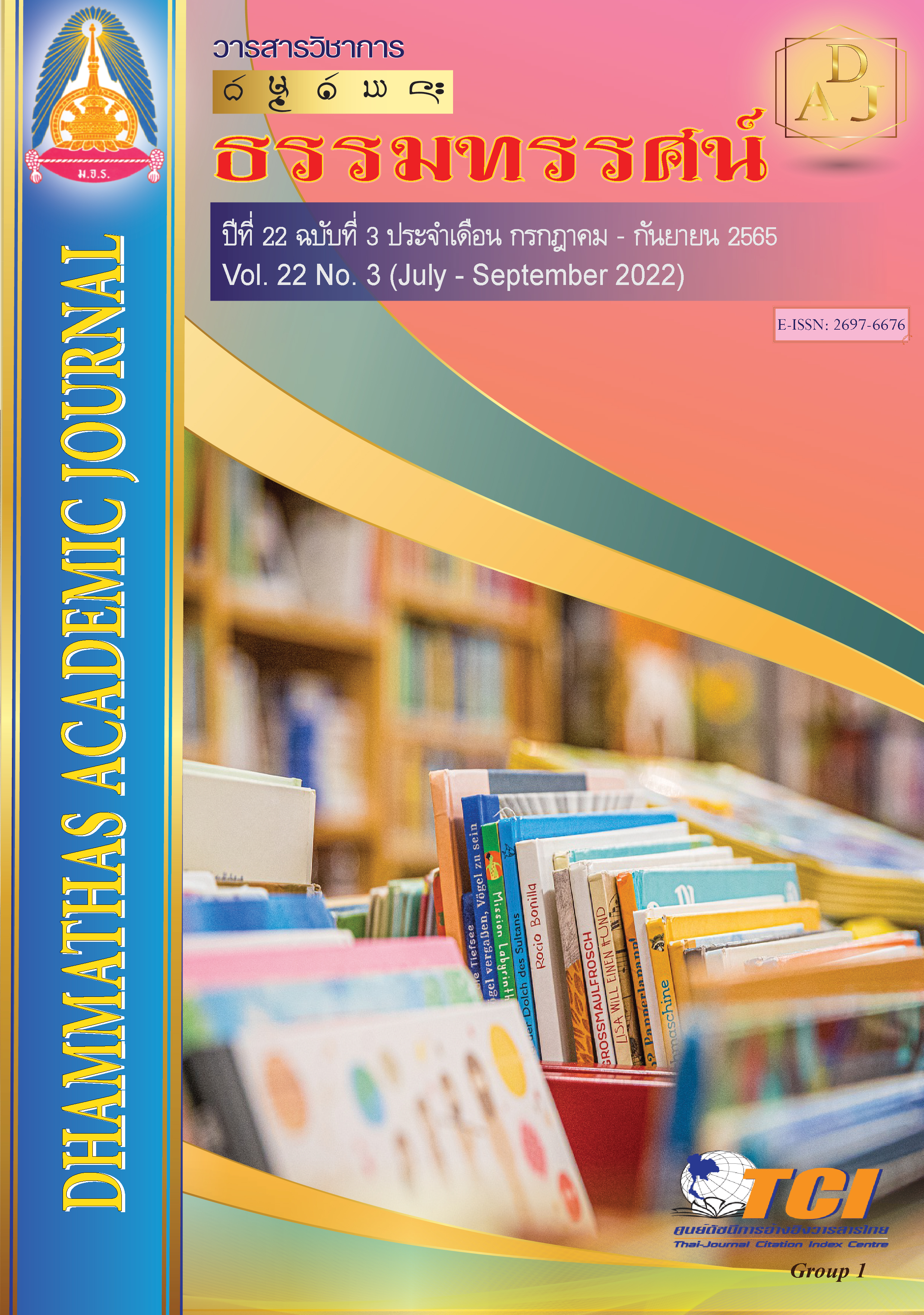A Study of Online Instructor ‘Characteristics, Online Learning Engagement and Pre-Service Teachers' Learning Style
Main Article Content
Abstract
This study aims to investigate desirable characteristics of online instructors, learning styles and online learning engagement of pre-service teachers and to compare their online learning engagement with the characteristics of online instructors which are preferable in their opinions. In this survey study, the samples were 242 undergraduate pre-service teachers at the University of Phayao. The data was collected using a questionnaire to survey pre-service teachers’ opinions on expected characteristics of online instructors and their online learning engagement
The results of this research were:
1. The pre-service teachers preferred online instructors who served as facilitators (M = 3.971, S.D. = .370).
2. Regarding their learning styles, they learned through reading and writing (R). (n = 69).
3. The pre-service teachers’ highest level of online engagement was in their commitment to learning (M = 4.194, S.D. = .636).
4. The overall of pre-service teachers with different backgrounds were not different in online instructors’ characteristics and online learning engagement. However, when considering each component, it was found that the pre-service teachers with different backgrounds had a different average level of online instructors’ characteristics in the third component: facilitator. Moreover, pre-service teachers with different backgrounds were different in the third element of engagement: commitment to study.
Article Details

This work is licensed under a Creative Commons Attribution-NonCommercial-NoDerivatives 4.0 International License.
เพื่อให้เป็นไปตามกฎหมายลิขสิทธิ์ ผู้นิพนธ์ทุกท่านต้องลงลายมือชื่อในแบบฟอร์มใบมอบลิขสิทธิ์บทความ ให้แก่วารสารฯ พร้อมกับบทความต้นฉบับที่ได้แก้ไขครั้งสุดท้าย นอกจากนี้ ผู้นิพนธ์ทุกท่านต้องยืนยันว่าบทความ ต้นฉบับที่ส่งมาตีพิมพ์นั้น ได้ส่งมาตีพิมพ์เฉพาะในวารสาร วิชาการธรรม ทรรศน์ เพียงแห่งเดียวเท่านั้น หากมีการใช้ ภาพหรือตารางของผู้นิพนธ์อื่นที่ปรากฏในสิ่งตีพิมพ์อื่นมาแล้ว ผู้นิพนธ์ต้องขออนุญาตเจ้าของลิขสิทธิ์ก่อน พร้อมทั้ง แสดงหนังสือที่ได้รับการยินยอมต่อบรรณาธิการ ก่อนที่บทความจะได้รับการตีพิมพ์References
โชติกา เศรษฐธัญการ. (2562). การศึกษาเปรียบเทียบความสามารถในการใช้ภาษาระหว่างเพศหญิงกับเพศชายที่สะท้อนให้เห็นภาพพจน์ทางเพศ. วารสารมังรายสาร, 7(2), 17-32.
ทรงทรรศน์ จินาพงศ์, สุริยา จันทนกูล และอานนท์ คงสุนทรกิจกุล. (2561). ลีลาการเรียนรู้ของนักศึกษาระดับปริญญาตรี สาขาวิชาพลศึกษาและวิทยาศาสตร์การกีฬา มหาวิทยาลัยนอร์ทกรุงเทพ. CMU Journal of Education, 2(2), 23-33.
Akinbobola, A. O. (2015). Effects of learning styles and instructional strategies on students’ achievement in Nigerian senior secondary school physics. Advances in Physics Theories and Applications, 41(1), 20-29.
Ammenwerth, E. (2017). Envisioning changing role of university teacher in online instructional environments. All Ireland Journal of Higher Education, 9(3).
Anggrawan, A., et al. (2019). Interaction between learning style and gender in mixed learning with 40% face-to-face learning and 60% online learning. International Journal of Advanced Computer Science and Applications (IJACSA), 10(5).
Batool, A., & Ahmad, S. (2019). Relationship Between Teachers’ Teaching Style and Learning Style of Students. Research on Humanities and Social Sciences, 9(23), 41-44.
Bryson, J. R., & Andres, L. (2020). Covid-19 and rapid adoption and improvisation of online teaching: curating resources for extensive versus intensive online learning experiences. Journal of Geography in Higher Education, 44(4), 608-623.
Chang, R. I., Hung, Y. H., & Lin, C. F. (2015). Survey of learning experiences and influence of learning style preferences on user intentions regarding MOOC s. British Journal of Educational Technology, 46(3), 528-541.
Cohen, J., et al. (2013). Applied Multiple Regression/Correlation Analysis for the Behavioral Science. New York: Routledge.
Clark, K. R. (2018). Learning theories: constructivism. Radiol Technol, 90(2), 180-182.
Czerkawski, B. C., & Lyman, E. W. (2016). An instructional design framework for fostering student engagement in online learning environments. Tech Trends, 60(6), 532-539.
Dunn, R. (1984). Learning style: State of the science. Theory into practice, 23(1), 10-19.
Fahim, A., et al. (2021). Identification of Preferred Learning Style of Medical and Dental Students Using VARK Questionnaire. BioMed Research International, 2021(4), 1-7.
Felder, R. M. (1993). Reaching the second tier. Journal of college science teaching, 23(5), 286-290.
Fleming, N. D., & Mills, C. (1992). Not another inventory, rather a catalyst for reflection. To improve the academy, 11(1), 137-155.
Foley, I. F. (1999). Teacher learning style preferences, student learning style preferences, and student reading achievement. University Of Houston.
Fry, S. W., & Villagomez, A. (2012). Writing to learn: Benefits and limitations. College Teaching, 60(4), 170-175.
Halif, M. M., et al. (2020). Moderating Effects of Student Motivation on the Relationship between Learning Styles and Student Engagement. Asian Journal of University Education, 16(2), 94-103.
Jayanama, B. (2017). Relationship between learning styles and academic achievement of low and high proficiency students in Foundation English of Srinakharinwirot. Scholar: Human Sciences, 9(2), 18-30.
Liu, M., & Shi, J. (2015). Chinese University Students’ Learning Styles: Gender and Discipline Differences. Institute for Learning Styles Journal, 1, 1-16.
Martin, F., et al. (2019). Award-winning faculty online teaching practices: Roles and competencies. Online Learning, 23(1), 184-205.
Min, Q., et al. (2018). A learning style model designed for online learning environments. International Journal of Information and Education Technology, 8(9), 623-627.
Rose, M. (2018). What are some key attributes of effective online teachers?. Journal of Open, Flexible and Distance Learning, 22(2), 32-48.
Setiawan, F. (2019). The Effectiveness of Mind Mapping and Brainstorming Techniques to Teach Writing to Visual and Read Write Learning Style Students. Syntax Literate; Jurnal Ilmiah Indonesia, 4(5), 64-79.
Taheri, M., et al. (2021). Analyzing the relationship between learning styles (Kolb and VARK) and creativity with the academic achievement of dental students. Journal of Education and Health Promotion, 10.
Tangen, J. L. (2018). Learning styles and supervision: A critical review. The Clinical Supervisor, 37(2), 241-256.
Wang, X., et al. (2021). Benefits of interactive graphic organizers in online learning: Evidence for generative learning theory. Journal of Educational Psychology, 113(5), 1024-1037.
Zain, S., et al. (2021). A survey on preferred learning styles among undergraduates during the ODL mode. Paper presented at the AIP Conference Proceedings. London: Blenheim Chalcot Company.

